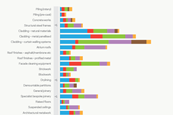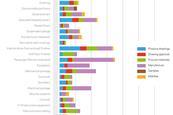Lead times: July–September 2020
No changes were seen in lead times this quarter, as availability issues with materials and labour caused by the pandemic were balanced out by falling demand related to Brexit
Lead times: January–June 2020
Lead times have proved remarkably resilient to change
Lead Times: October - December 2019
There was minimal movement in lead times despite some packages experiencing a change in enquiry levels and workloads
Lead Times: July-September 2019
The past quarter has again shown little movement, with lead times static for all but three packages
Lead times: April - June 2019
The forecast is for little change with workload and enquiry levels being static
Lead times: January - March 2019
Lead times have remained static, but widespread reports of labour shortages mean firms are starting to predict increases soon
Lead times: October - December 2018
The past quarter has again shown little movement, however, growing uncertainty over Brexit means this steadiness could soon change
Lead times: July-September 2018
With workload and enquiries remaining level, lead times stayed steady for all except two packages – both were driven higher by pressure on design and manufacturing resources
Lead times: April-June 2018
More packages experienced an increase in lead times than in the previous quarter, while a growing number of companies are struggling to find skilled labour as workloads increase
Lead times: January-March 2018
In this quarter, three packages report a shortening of lead times – reflecting the beginning of a decline in enquiries
Lead times: October-December 2017
Our previous look at lead times back in September forecast little alteration, but as it turned out there were no changes at all over the subsequent three months
Lead times: July-September 2017
Companies report being busier, and the lead times of several packages have changed but most have remained level, while little alteration is expected in the next six months
Lead times: April-June 2017
Lead times have stayed level, with most packages at the highest level since records began, and little further change is expected over the next six months
Lead times: January-March 2017
Lead times have changed for five packages and four are increasing again, but many packages still expect no change in the next six months despite increased workload and enquiries
Lead times: October - December 2016
Lead times have changed for only two packages - the lowest level of change recorded in the last decade. But many packages are reporting difficulty in getting qualified or experienced staff, reports Brian Moone of Mace
Lead times: July - September 2016
There are capacity issues with some off-site manufacturing but the consensus among other site-based trades is that lead times are stabilising
Lead times: April - June 2016
Lead times have either remained the same or increased, with burgeoning workloads and enquiries and a shortage of skilled labour making further increases more likely
Lead times: Jan - Mar 2016
After a period of increase due to heavier workloads, lead times seem to be levelling off. But fit-out and finishing trades are still in hot demand
Lead times: Oct - Dec 2015
Increases to lead times continue, and many are forecast to rise in the next six months, as workload and enquiries grow. But staffing is still an issue
Lead times: July - Sept 2015
Increases to lead times continue, albeit to a smaller number of trades than seen in previous quarters. The major issue forecast going forward is labour shortages








































